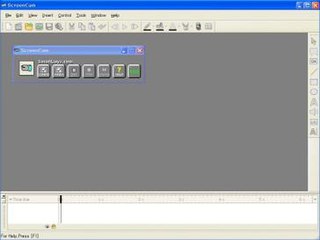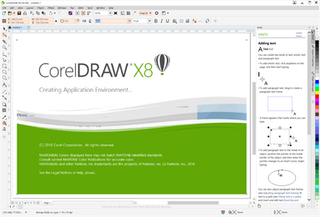
Lotus 1-2-3 is a discontinued spreadsheet program from Lotus Software. It was the first killer application of the IBM PC, was hugely popular in the 1980s, and significantly contributed to the success of IBM PC-compatibles in the business market.

SmartSuite is a discontinued office suite from Lotus Software. The company made versions of its office suite for IBM OS/2 and Microsoft Windows.

PagePlus was a desktop publishing program developed by Serif for Microsoft Windows. The first version was released in 1991 as the first commercial sub-£100 DTP package for Microsoft Windows. The final release was PagePlus X9, which was released in November 2016. In June 2019 it was officially replaced by Serif with Affinity Publisher.
Lotus Symphony was an integrated software package for creating and editing text, spreadsheets, charts and other documents on the MS-DOS operating systems. It was released by Lotus Development as a follow-on to its popular spreadsheet program, Lotus 1-2-3, and was produced from 1984 to 1992. Lotus Jazz on the Apple Macintosh was a sibling product.
Lotus Software was an American software company based in Massachusetts; it was "offloaded" to India's HCL Technologies in 2018.
Wingz was a spreadsheet program sold by Informix in the late 1980s and early 1990s. Originally developed for the Macintosh, it was later ported to Microsoft Windows, OS/2, NeXTSTEP and several other commercial flavors of Unix. In spite of many positive reviews, including one calling it "clearly the spreadsheet of the future", the market was rapidly entrenching Microsoft Excel. Informix eventually gave up on the desktop market and reverted solely to database sales in the mid-1990s. Claris licensed and sold an extensively cleaned up version as Claris Resolve in 1991, but it was far too late to market to have any effect.
A number of vector graphics editors exist for various platforms. Potential users of these editors will make a comparison of vector graphics editors based on factors such as the availability for the user's platform, the software license, the feature set, the merits of the user interface (UI) and the focus of the program. Some programs are more suitable for artistic work while others are better for technical drawings. Another important factor is the application's support of various vector and bitmap image formats for import and export.
The following tables compare general and technical information for a number of office suites:

Spinnaker Software Corporation was a software company founded in 1982 known primarily for its line of non-curriculum based educational software, which was a major seller during the 1980s. It was founded by chairman Bill Bowman and president C. David Seuss.
This is an overview of software support for the OpenDocument format, an open document file format for saving and exchanging editable office documents.

Lotus Freelance Graphics is an information graphics and presentation program developed by Lotus Software following its acquisition of Graphic Communications Inc in 1986. It was first released for DOS and OS/2 operating systems, then later released as part of the Lotus SmartSuite for Microsoft Windows.

pfs:Write was a word processor created by Software Publishing Corporation (SPC) and published in 1983. It was released for IBM PC compatibles and the Apple II. It includes the features common to most word processors of the day, including word wrapping, spell checking, copy and paste, underlining, and boldfacing; and it also a few advanced features, such as mail merge and few others. The product was considerably easier to both learn and use than its more fully featured and expensive competitors: WordPerfect, Microsoft Word, and XyWrite.
Q&A was a database and word processing software program for IBM PC–compatible computers published by Symantec and partners from 1985 to 1998. It was written by a team headed by Symantec founder Dr. Gary Hendrix, Denis Coleman, and Gordon Eubanks.

ScreenCam is a screencast tool for Microsoft Windows that is used to author software demonstrations, software simulations, branched scenarios, and tutorials in .swf format. ScreenCam was primarily targeted at users who need to create video-oriented instructional materials who were not multimedia authors or video capture technicians. It was very easy to use, having a 'VCR-like' interface and requiring no knowledge of digital video editing, or the concept of 'frames' of a movie, because it used a different paradigm for creating the screen movies. It can also be used for creation of screencasts and conversion of Microsoft PowerPoint presentations to the Adobe Flash format.

Windows 3.0 is the third major release of Microsoft Windows, launched in 1990. It features a new graphical user interface (GUI) where applications are represented as clickable icons, as opposed to the list of file names seen in its predecessors. Later updates would expand the software's capabilities, one of which added multimedia support for sound recording and playback, as well as support for CD-ROMs.
Serif have a range of software products, which are listed below.

CorelDRAW is a vector graphics editor developed and marketed by Alludo. It is also the name of the Corel graphics suite, which includes the bitmap-image editor Corel Photo-Paint as well as other graphics-related programs. It can serve as a digital painting platform, desktop publishing suite, and is commonly used for production art in signmaking, vinyl and laser cutting and engraving, print-on-demand and other industry processes. Reduced-feature Standard and Essentials versions are also offered.
Software Publishing Corporation (SPC) was a Mountain View, California-based manufacturer of business software, originally well known for its "pfs:" series of business software products, it was ultimately best known for its pioneering Harvard Graphics business and presentation graphics program.
Trapeze is a discontinued spreadsheet program for Macintosh systems running classic Mac OS. It introduced the concept of using named ranges for most operations instead of cell addresses, allowing formulas to be freed of the location of the data on the page. This, in turn, made updating the sheets by moving data around a safe operation, whereas in contemporary programs like Microsoft Excel and Lotus 1-2-3 this often led to broken formulas. The system did not rely on the sheet as the basis for storage, and allowed multiple tables, charts, graphics and text, which they referred to as "blocks", to be positioned freely.







